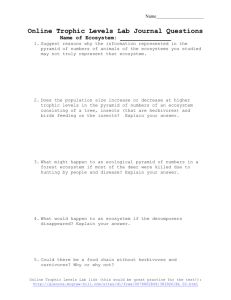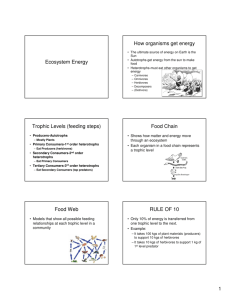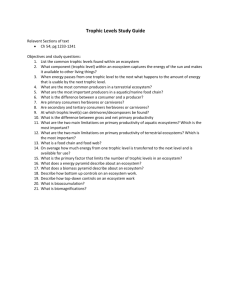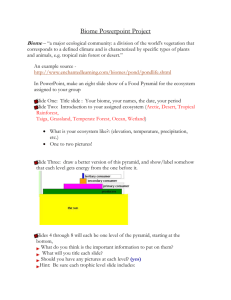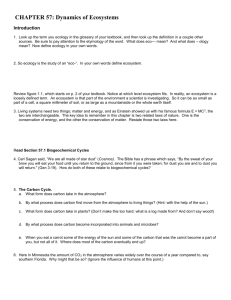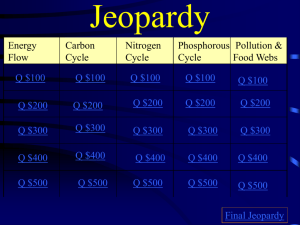Skills Worksheet
advertisement
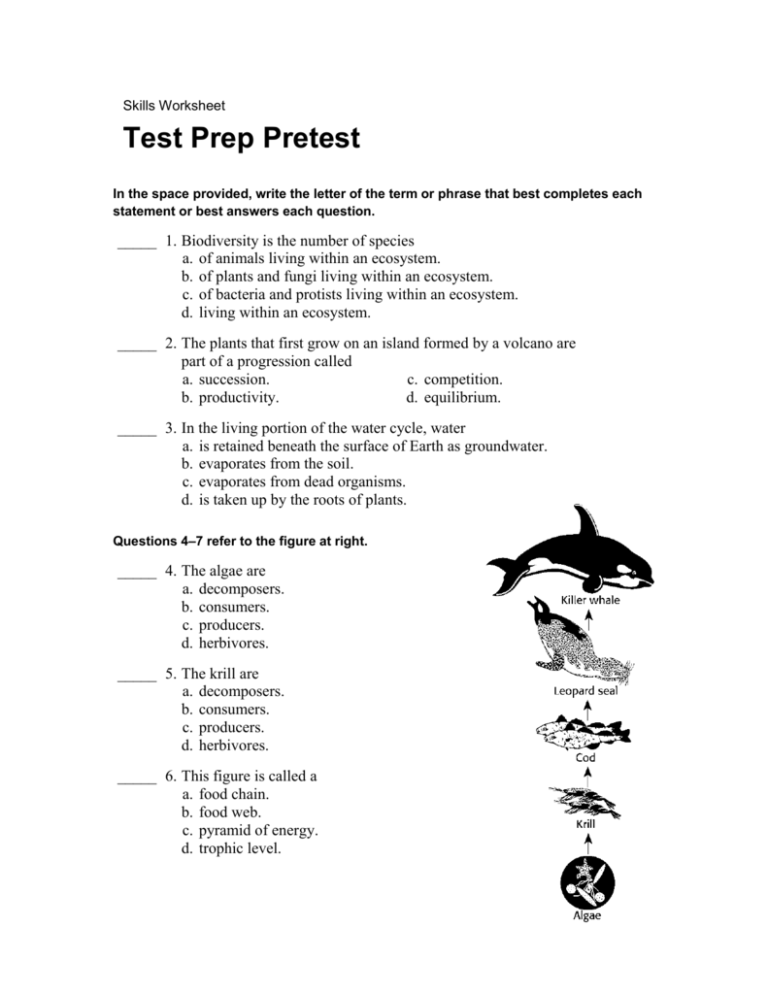
Skills Worksheet Test Prep Pretest In the space provided, write the letter of the term or phrase that best completes each statement or best answers each question. _____ 1. Biodiversity is the number of species a. of animals living within an ecosystem. b. of plants and fungi living within an ecosystem. c. of bacteria and protists living within an ecosystem. d. living within an ecosystem. _____ 2. The plants that first grow on an island formed by a volcano are part of a progression called a. succession. c. competition. b. productivity. d. equilibrium. _____ 3. In the living portion of the water cycle, water a. is retained beneath the surface of Earth as groundwater. b. evaporates from the soil. c. evaporates from dead organisms. d. is taken up by the roots of plants. Questions 4–7 refer to the figure at right. _____ 4. The algae are a. decomposers. b. consumers. c. producers. d. herbivores. _____ 5. The krill are a. decomposers. b. consumers. c. producers. d. herbivores. _____ 6. This figure is called a a. food chain. b. food web. c. pyramid of energy. d. trophic level. Test Prep Pretest continued _____ 7. The most likely reason that this figure shows only five levels is that a. pollution probably destroyed all of the higher levels. b. no other organisms are powerful enough to kill and eat the killer whale. c. too much energy is lost at each level to permit more levels. d. there is not enough energy initially present at the first level. _____ 8. The process of succession varies depending on a. the plant species involved. b. initial environmental conditions and chance. c. pioneer species. d. competition between species. _____ 9. The conversion of nitrate to nitrogen gas is called a. assimilation. c. nitrification. b. ammonification. d. denitrification. In the space provided, write the letter of the description that best matches the term or phrase. _____ 10. habitat _____ 11. community _____ 12. ecosystem _____ 13. herbivores _____ 14. carnivores a. animals at the second trophic level that eat plants b. the place where a particular population of a species lives c. the many species that live together in a habitat d. animals at the third trophic level that eat other animals e. a community and all the physical aspects of its habitat Complete each statement by writing the correct term or phrase in the space provided. 15. The physical aspects of an ecosystem, or its ______________________ _____________________, include soil, water, and weather. 16. In a(n) ______________________ ______________________ , the amount of energy stored at each level determines the width of each block. 17. The amount of energy that can be passed on to the third trophic level is about ______________________ percent of the amount of energy available to the ______________________ trophic level. Test Prep Pretest continued 18. The process of combining nitrogen gas with hydrogen to form ammonia is called ______________________ ______________________ . 19. The production of ammonia by bacteria during the decay of animal waste is called ______________________. Read each question, and write your answer in the space provided. 20. What components are included in an ecosystem but not in a community? ______________________________________________________________ ______________________________________________________________ ______________________________________________________________ 21. Why are energy pyramids never inverted? ______________________________________________________________ ______________________________________________________________ ______________________________________________________________ 22. Trace the cycling of water between the atmosphere and Earth. ______________________________________________________________ ______________________________________________________________ ______________________________________________________________ ______________________________________________________________ 23. List the four stages of the nitrogen cycle. ______________________________________________________________ ______________________________________________________________ ______________________________________________________________ Test Prep Pretest continued Questions 24 and 25 refer to the figure below, which shows the carbon cycle. 24. How do the living organisms in the figure return carbon atoms to the pool of carbon dioxide in the atmosphere and water? ______________________________________________________________ ______________________________________________________________ ______________________________________________________________ 25. What process releases carbon into the atmosphere from fossil fuels? ______________________________________________________________ Test Prep Answer Key 1. d 8. b 2. a 9. d 3. d 10. b 4. c 11. c 5. b 12. e 6. a 13. a 7. c 14. d 15. abiotic factors 16. energy pyramid 17. 10, second 18. nitrogen fixation 19. ammonification 20. abiotic factors such as soil, water, and weather 21. Energy is always lost when it is transferred from one trophic level to the next. 22. Water enters the atmosphere through evaporation and transpiration. It returns to Earth as precipitation. 23. assimilation, ammonification, nitrification, and denitrification 24. by breaking down organic molecules in cellular respiration and by death and decomposition 25. combustion



